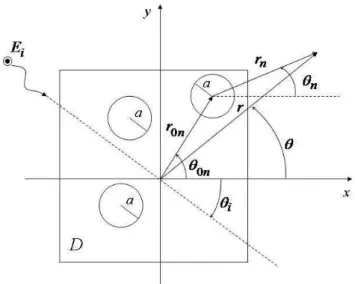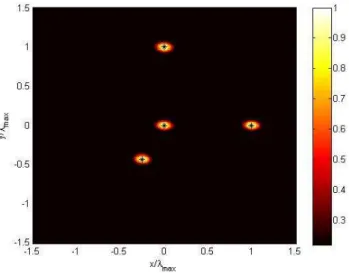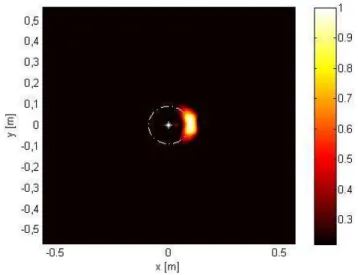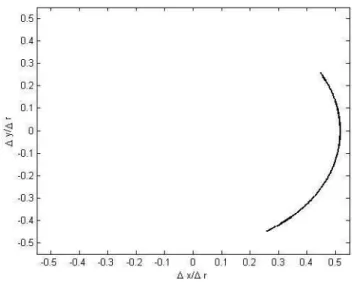www.adv-geosci.net/19/11/2008/
© Author(s) 2008. This work is distributed under the Creative Commons Attribution 3.0 License.
Geosciences
An algorithm for localization of cylinders by reflection mode
scattered field
A. Brancaccio, C. Di Dio, and G. Leone
Dipartimento di Ingegneria dell’Informazione – Seconda Universita’ di Napoli, Italy
Received: 27 June 2008 – Revised: 11 September 2008 – Accepted: 24 September 2008 – Published: 14 November 2008
Abstract.The problem of localizing perfectly electrical con-ducting cylinders of arbitrary radius is dealt with in a two dimensional geometry. A reflection mode multi-frequency multi-bistatic configuration is considered, and a linear inver-sion algorithm based on the truncated singular values decom-position is proposed. The algorithm is validated against sim-ulated data, and the effect of errors in the knowledge of the cylinders’ radius is discussed.
1 Introduction
The reflection mode configuration is used, in non destructive testing and subsurface prospecting, in every circumstance where the investigation domain is accessible from only one side. For instance, this happens in the detection and local-ization of buried pipes or in NDT of rebars in concrete, and in general in ground penetrating radar applications. In this paper the problem of localizing objects by measurements of the electromagnetic field scattered when observed in reflec-tion mode is considered for Perfectly Electrical Conducting (PEC) cylinders.
The localization problem has been already addressed in the hypothesis of “small” (with respect to the wavelength) scat-terers (Pierri et al., 2005, and references therein). Otherwise, a “shape” reconstruction inverse problem can be formulated (Soldovieri et al., 2005, and references therein).
Here, we propose an algorithm for the localization of PEC circular cylinders whose radius can be comparable or larger than the wavelength. The algorithm is based on the inversion of a linear operator, strictly related to the one used in (Pierri et al., 2005). The fact that the scatterers are not “thin” results in the presence of a frequency dependent factor outside the
Correspondence to:A. Brancaccio (adriana.brancaccio@unina2.it)
integral operator linking data and unknown. Such a factor de-pends on the shape of the scatterer section, that is a circle in the present case. If the cylinder’s radius is not known an er-ror in localization arises and how it affects the reconstructed image is also discussed.
The paper is organized as follows. In Sect. 2 the problem is formulated and the inversion algorithm is introduced. In Sect. 3 the dependence of the inversion result on the correct knowledge of the cylinders’ radius is discussed. In Sect. 4 a numerical analysis is performed and results obtained by simulated data are shown. Conclusions follow.
2 Formulation of the problem
Let us considerN infinitely long circular PEC cylinders il-luminated by TM polarized plane waves. We want to find the positions of the centers of the cylinders, that are assumed to be embedded within a homogeneous medium of known permittivityǫr and residing within the investigation domain
D. Furthermore, we assume that all the cylinders have the same radiusa. The problem at hand is a two dimensional one. From now onwards we indicate the centers of the cylin-ders’ circular cross sections as cylinder’s positions. The field scattered by the n-th cylinder can be written as (Harrington, 2001)
Ens = −E0 +∞ X
p=−∞
(−j )p Jp(ka) Hp(2)(ka)
ejp(θn−θi)H(2)
p (krn) (1)
whereE0is the incident field amplitude at the cylinder
posi-tion,kis the wavenumber,θi is the incidence angle,Jp(·)is
the Bessel function of orderp,Hp(2)(·)is the Hankel function
of orderpand second kind, (rn, θn) denote the polar
12 A. Brancaccio et al.: Localization of cylinders
Fig. 1.Geometry of the problem.
The scattered far field, in a gobal reference system (r, θ) whose origin is located somewhere inside the investigation domainD, can be easily derived from Eq. (1) by translating the origin of the system and approximating for large argu-ment the Hankel function. It results:
Esn= −E0 r
2j π kre
−j kr +∞X
p=−∞
Jp(ka)
Hp(2)(ka)
ejp(θ−θi)·
·e−j kr0n[cos(θ0n−θi)−cos(θ0n−θ )] (2)
wherer0nandθ0ndenote the position of the n-th cylinder and
the factor e−j kr0n[cos(θ0n−θi)] accounts for the incident field
phase at that position. Then, if the mutual scattering between the cylinders is neglected, the field scattered by all the cylin-ders is given by the superpositionPN
n=1Ens:
Es = −E0 r
2j π kre
−j kr +∞X
p=−∞
Jp(ka)
Hp(2)(ka)
ejp(θ−θi)·
·
N X
n=1
e−j kr0n[cos(θ0n−θi)−cos(θ0n−θ )] (3)
Our aim is to determine the position of the scatterers starting from the observed scattered field.
However, it is not convenient to deal with the problem us-ing directly as unknowns the coordinates r0n and θ0n,
be-cause the relationship between data and unknowns would be strongly non linear. In order to linearize the problem we introduce the auxiliary distributional function (Pierri et al., 2005):
γ (r)=
N X
n=1
δ(r−r0n) (4)
whereris the position vector andr0nis the vector indicating the position of then-th cylinder in the reference plane.
Now, the problem at hand can be recast as the inversion of the following linear operator equation:
Es =F (ka) Z
D
γ (x, y)e−j (ux+vy)dxdy (5) where
F (ka)= −E0 r
2j π kre
−j kr P X
p=−P
Jp(ka)
Hp(2)(ka)
ejp(θ−θi) (6)
and u=k(cosθi−cosθ ), v=k(sinθi−sinθ ), the cartesian
coordinatesx, y have been used inside the integral and the sum has been truncated according to the rule P≈ka (pro-videdka≫1) (Brancaccio et al., 1998). The functionγ (r)is the unknown to be recovered. Its maxima give the searched for positions. Before going on it is worth to make two com-ments about Eq. (5):
1. the integral operator appearing at the second member is the same studied in (Pierri et al., 2005) for the localiza-tion of thin scatterers;
2. the information about the ’size’ of the scatterers stands as a frequency dependent factorF (ka).
According to Eqs. (5) and (4), we solve the problem of de-termining the location of the cylinders from the knowledge of Es in three steps. First, Es is normalized to the factor
F (ka). This step requires that the radiusais the same for all the involved scatterers and that it is known. We discuss in the following about such point. Second, the distributionγis ap-proximately reconstructed, which amounts to invert a linear integral operator. This task is accomplished by means of the Singular Value Decomposition (SVD) approach, that allows to regularize the problem by truncating the expansion accord-ing to the uncertainties level (TSVD inverse scheme). Third, the total number of scatterers and their unknown positions are determined as the locus of points where the retrieved dis-tribution achieves its maxima. In order to find such points a threshold is introduced below which the reconstruction is discarded. In particular, the threshold is chosen using the results reported in (Liseno et al., 2004).
Fig. 2. Reconstructed positions of four cylinders of radius a=0.1λmax(the actual positions are indicted by a black star).
3 Discussion
Let us analyze the importance of a correct knowledge of the radiusain order to localize the scatterers.
Actually, the assumed value ofainfluences the normaliza-tion factorF (ka), whose expression is given in Eq. (6). In the present multibistatic configuration(θ−θi)has a constant
known value and the normalization factor depends only on ka, i.e. on the scatterers dimension with respect to the wave-length.
The function F (ka) is nothing else that the scattered field by a single circular cylinder along the θ direction for plane wave incidence from direction θi. As well
known (Tyras, 1969) the Watson transform and asymp-totic arguments allow to approximate such a factor as the Geometric Optics reflected field so that it is propor-tional to −E0√a/2∗cos(1θ/2)exp[+j2kacos(1θ/2)−
j kr]where1θ=θ−θi−πis the offset between the
obser-vation and the incidence direction. Therefore, the amplitude ofF (ka)is constant and the phase shows a linear frequency behavior. While the influence of the phase function is dis-cussed in detail hereafter, the independence of the modulus ofF (ka)from the frequency makes the SVD decomposition of the full operator (5) equal to the one considered in (Pierri et al., 2005) with the same singular values behavior.
Once the normalization has been performed, if the radius value is not exactly known, a residue phase factor exp(j k1r) is present in the operator linking data and unknown (note that1r can be both positive and negative). In this case (see Appendix A) the integral kernel in Eq. (5) can be written as:
ej k1re−j (ux+vy)=e−j[u(x+1x)+v(y+1y)] (7)
Fig. 3. Reconstructed positions of two cylinders of radius a=0.5λmax(the actual positions are indicted by a black star).
where
1x=− 1r
2(1+cos1θ )[(1+cos1θ )cosθi−sin1θsinθi] (8) and
1y=− 1r
2(1+cos1θ )[(1+cos1θ )sinθi+sin1θcosθi] (9) Therefore such an error affects the localization of the cylinder by an amount connected to 1x and 1y. In Ap-pendix A we show that, for each scatterer, instead of a peaked function in the reconstructed image, an arc of circle of radius
|1r|/√2(1+cos1θ ), centered on the actual scatterer posi-tion, should be expected. In particular, if the radiusais un-derestimated1r>0 and the reconstructed image appears as an arc convex with respect to the measurement domain; in-stead, in case of overestimation1r<0 and the reconstructed image appears as an arc concave with respect to the measure-ment domain.
4 Numerical results
We consider a realistic geometry in which data are collected in a reflection mode under a multi-bistatic configuration.
A stepped frequency illumination is considered, so that k ∈ h2πfmin√ǫr
c0 ,
2πfmax√ǫr
c0
i
where fmax and fmin are the
maximum and minimum frequency respectively, and c0 is
the speed of light in a vacuum space. In the following ex-amples we use fmax=2 GHz, fmin=400 MHz, with a
fre-quency step of 50 Mhz,ǫr=4. The investigation domain is
D=[−1.5λmax,1.5λmax]×[−1.5λmax,1.5λmax] in thex, y
plane, whereλmaxis the maximum wavelength calculated
in-side the background medium (λmax=37.5 cm in the
14 A. Brancaccio et al.: Localization of cylinders
Fig. 4. Reconstructed positions of two cylinders of radius a=1.5λmax(the actual positions are indicted by a black star).
Fig. 5.Reconstruction result for a cylinder of radiusa=10 cm when a wrong valuea=1 cm is assumed in the inversion algorithm (the actual position is indicted by a white star).
π/2 rad and the offset between the source and the receiver is π/20 rad, i.e.θ−θi=π−π/20 rad.
In all the following examples, the SVD is truncated to the singular value index 10 dB lower than the maximum one. Moreover, the reconstructed functions are normalized to their maximum value and the final images are not depicted under a threshold level 0.21 times the maximum one.
First, in order to show the effectiveness of the proposed algorithm, we assume that the radius a of the cylinders is known exactly. In Figs. (2), (3), (4) the reconstructed positions of cylinders of radius a=0.1λmax, a=0.5λmax,
a=1.5λmaxare shown respectively. As can be seen, the
ac-Fig. 6.Reconstruction result for a cylinder of radiusa=10 cm when a wrong valuea=20 cm is assumed in the inversion algorithm (the actual position is indicted by a white star).
Fig. 7.Reconstruction result for two cylinders of radiusa=0.7λmax
and a=1.2λmax, located at (x, y)=(−0.75λmax,0.75λmax) and (x, y)=(0,−1.2λmax)respectively; a=0.7λmaxis assumed in the
inversion algorithm.
We consider now the case in which the scatterers have dif-ferent radii. In this case, the algorithm can provide the cor-rect localization of the cylinders whose radius is equal to that used in the normalization factorF (ka), while, following the arguments discussed above, we expect that the position of any other cylinder should be reconstructed as a circular arc. Such a result is confirmed by the example shown in Fig. 7.
5 Conclusions
In this paper we have performed the extension of an algo-rithm for localization of thin PEC cylinders to a collection of identical cylinders of arbitrary radius. The algorithm has been validated against simulated data and the effect of errors in the knowledge of the cylinders’ radius on the reconstructed images has been examined.
We considered the case of far zone scattered field in reflec-tion mode configurareflec-tion and limited extension of the obser-vation domain, that is preliminary to subsurface prospection. The extension to dielectric objects, near zone observation and half space geometry is under development.
Appendix A
Let us define the unitary vectors: iˆθi=(cosθi,sinθi),
indicating the incident field propagation direction,
ˆ
i⊥=(sinθi,−cosθi), orthogonal toˆiθi in thex, y plane, and
the vector iD=(1+cos1θ,−sin1θ ) (where the x and y cartesian components are indicated in brackets). We can express the variables u and v (introduced in Eq. 5) as a function of1θ:
u=k(1+cos1θ )cosθi −ksin1θsinθi, (A1)
v=k(1+cos1θ )sinθi+ksin1θcosθi, (A2)
that can be rewritten, by exploiting the above defined vectors, as:
u=kiD· ˆiθi;v=kiD· ˆi⊥, (A3) Let us now write the productk1ras a function of the vec-toriD:
k1r= kiD·1riD
|iD|2 (A4)
Then, we can project each vector at the second member of Eq. A4 ontoˆiθiandˆi⊥. So, we have:
(kiD· ˆiθiˆiθi +kiD· ˆi⊥ˆi⊥)·(1riD· ˆiθiˆiθi+1riD· ˆi⊥iˆ⊥)=
=u1riD· ˆiθi+v1riD· ˆi⊥ (A5)
Fig. A1. Expected displacement in the reconstruction in presence of a phase error.
where the expressions Eq. A3 foruandv have been used. Finally:
k1r−ux−vy= −u(x− 1riD· ˆiθi
2(1+cos1θ ))−
−v(y− 1riD· ˆi⊥
2(1+cos1θ )). (A6)
We can conclude that, in presence of a phase factork1r, a displacement with respect to the coordinatesx, yis experi-enced. Such displacement is given by
1x= − 1r
2(1+cos1θ )iD· ˆiθi
= − 1r
2(1+cos1θ )[(1+cos1θ )cosθi−sin1θsinθi] (A7) and
1y= − 1r
2(1+cos1θ )iD· ˆi⊥
= − 1r
2(1+cos1θ )[(1+cos1θ )sinθi+sin1θcosθi] (A8) That are the expressions reported in Eqs. 8 and 9. Such displacements represent the parametric equation of a circle of radius|1r|/√2(1+cos1θ )in thex, yplane, at variance of the incidence angleθi. In Fig. A1 an example of such a
curve is plotted for1θ=π/6 andθi ∈ [−π/4, π/4], in the
case1r>0.
Edited by: F. Soldovieri
16 A. Brancaccio et al.: Localization of cylinders
References
Pierri, R., Solimene, R., Liseno, A., and Romano, J.: Linear distri-bution imaging of thin metallic cylinders under mutual scatter-ing, IEEE Trans. Antennas Propag., 53, 3019–3029, 2005. Soldovieri, F., Brancaccio, A., Leone, G., and Pierri, R.: Shape
Re-construction of Perfectly Conducting Objects by Multiview Ex-perimental Data, IEEE Trans. Geosc. Remote Sens., 43, 65–71, 2005.
Harrington, R. F.: Time Harmonic Electromagnetic Fields, Ed. Wi-ley and Sons, 2001.
Brancaccio, A., Leone, G., and Pierri, R.: Information content of Born scattered fields: results in the circular cylindrical case, J. Opt. Soc. Am., 15, 1909–1917, 1998.
Liseno, A., Soldovieri, F., and Pierri, R.: Improving a shape recon-struction algorithm with thresholds and multi-view data, AEU, International Journal of Electronics and Communications, 58, 118–124, 2004.
Soldovieri, F. and Persico, R.: Reconstruction of an Embedded Slab from Multifrequency Scattered Field Data Under the Distorted Born Approximation, IEEE Trans. Antennas Propag., 52, 2348– 2356, 2004.



